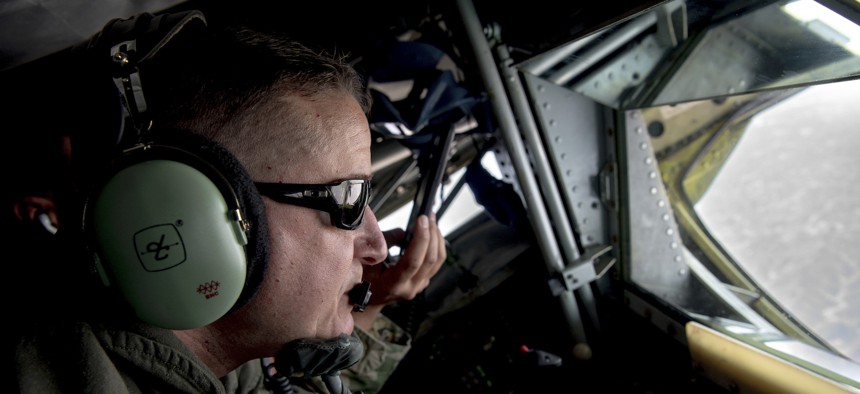
U.S. Air Force Master Sgt. Christopher Bishop, a boom operator assigned to the Maine National Guard's 101st Air Refueling Wing, refuels a U.S. Air Force F-16 Fighting Falcon, assigned to the Ohio National Guard's 180th Fighter Wing, from a KC-135, assigned to the 101ARW, on their way to Key West, Florida, Oct. 29, 2022. U.S. Air National Guard / Staff Sgt. Kregg York
The Air & Space Brief: F-15s, retiring; Drone threat, rising; China’s nuke options, expanding; and more
Welcome to the Defense One Air and Space newsletter. Here are our top stories this week:
Out with the old. The U.S. Air Force today began a phased withdrawal of all F-15C and D models from Kadena Air Base in Okinawa, Japan, Pentagon spokesman Brig. Gen. Patrick Ryder told reporters Tuesday. Removing the aircraft, which have been in service for “more than 30 years,” is part of the service’s modernization plan, Ryder said. For now, USAF will backfill the planes, which were permanently stationed on the island, with “advanced 4th-gen and 5th gen aircraft,” on a rotational basis, Ryder said. Air & Space Forces Magazine has more details, here.
Rising drone threat. A new assessment of global missile threats indicates that the U.S. and its allies are being increasingly threatened by drones and cruise missiles, Defense One’s Marcus Weisgerber reports. The use of drones “will likely expand and continue to pose a threat to U.S. personnel overseas, allies and partners, and potentially to the U.S. homeland,” according to the Missile Defense Review.
China’s nukes. China’s nuclear arsenal is expanding, and the United States will soon have to deter “two major nuclear armed competitors”—Russia and China—which “presents new dilemmas for both strategic deterrence and for regional warfighting,” a senior defense official said Thursday. That change is reflected in the Biden administration’s new Nuclear Posture Review, Defense One’s Marcus Weisgerber reports.
Air Force cyber update: The Department of the Air Force’s Sentinel Stand multidisciplinary task force is in the midst of mapping out “which bases, systems, networks, assets, and infrastructure would be necessary to fight a war with China,” Defense One’s Lauren C. Williams reports. The task force has already looked at bases in the Indo-Pacific region and will work through the combatant commands over the next year, said the service’s principal cyber advisor, Wanda Jones-Heath. Sentinel Stand will also work to address Space Force problems, she said. “Our satellites are very old, and… in order to win the war, you have to have space superiority along with air,” Jones-Heath said.
Sign up to get The Air & Space Brief every Tuesday from Jennifer Hlad, Defense One’s news editor. On this day in 1952, the United States detonated the world’s first hydrogen bomb in a test at Eniwetok, in the Marshall Islands.
 From Defense One
From Defense One
Defense One Radio, Ep. 111: Drones in Russia's Ukraine war, and elsewhere // Ben Watson
We focus on the latest developments in unmanned aerial systems, from the front lines to a conference in Washington.
Drones, Cruise Missiles Are Rising Threats to US Troops and Territory, Pentagon Says // Marcus Weisgerber
The Missile Defense Review also calls for building a missile shield to protect Guam.
China's Nuclear Arsenal Will Become an Existential Threat to US, Biden Administration Declares // Marcus Weisgerber
New nuclear strategy deletes one new U.S. weapon, keeps the rest.
How Is the Air Force Doing at Cyber? // Lauren C. Williams
To answer the question, a new task force is working to map the service's networks.




